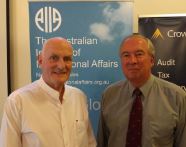The War in Syria
At AIIA NSW’s first lecture for 2016, Clive Williams, an Australian military intelligence officer and terrorism expert, addressed an overflowing crowd at Glover Cottages on Tuesday 2 February. He focused on the war in Syria and the refugee crisis. Briefly a kingdom in 1920, then a French mandate, a republic from 1938, Syria gained independence in 1946. Unstable during most of the ’50s and ’60s, the country gathered direction and stability under Hafez al-Assad whose Ba’ath Party gained power in 1970. Following his death in 2000, Hafez was followed by his middle son Bashar. Western observers had high hopes for Bashar. English-speaking and educated, an Alawite but religiously tolerant, Bashar appeared likely to be a successful, even sensitive leader. But his heavy-handed over-reaction to protests associated with the 2011 Arab Spring led to civilian bloodshed and a hydra-headed metamorphosis of rebel organisations opposing him. Their various backers include Saudi Arabia and Qatar which want to run Syria on fundamentalist Sunni lines; Iran which wants Syrian Shi’a to dominate; Turkey which has its own interests, including the control of Kurds and oil. With its highly selective bombing targets, the United States and its allies tip-toe delicately among possible targets and are reluctant to put more than a few specialised boots on the ground. Russia has no such constraints. Committed to supporting the government in Damascus, its air force bombs Assad’s perceived enemies without apparent concern for civilian casualties or the waves of additional refugees fleeing to safe havens in Europe they encourage.
In earlier days of the civil war, refugees found passage through Greece and Hungary into northern Europe. Macedonia allowed transit visas for refugees, which created a surge in migration. Europe’s open door policy encouraged the flow. Now, fences of exclusion have been constructed throughout the Balkans. Resistance to the influx has found further expression. The French don’t want any Muslim refugees. Too polite to really say so, neither does Britain. The Scandinavians are also becoming reserved. Denmark in particular is almost united in its opposition. Under Angela Merkel’s leadership, Germany initially welcomed refugees, but since the 2016 New Year incidents of rape and assault of German women at Cologne railway station and elsewhere, resistance to refugees has spread throughout the country. Unaccompanied males are of particular concern – are they Islamic zealots, fondlers and rapists of unaccompanied women, potential or actual terrorists? Merkel’s political stocks have fallen dramatically. Russia, the largest recipient of refugees in 2014, continues to take them. Under Trudeau, Canada has pledged to take 25,000 refugees, but not unaccompanied males. Australia will take 12,000, but they must come out of our humanitarian quota, so others in the queue will be bumped. Some refugees are beginning to return to their countries of origin in the Middle East, but not yet in any substantial numbers to the mayhem that is Syria. The future is difficult to predict, but the plight of Syrian refugees is likely to continue, if possible even to get worse, before it improves.
Report prepared by Richard Broinowski
